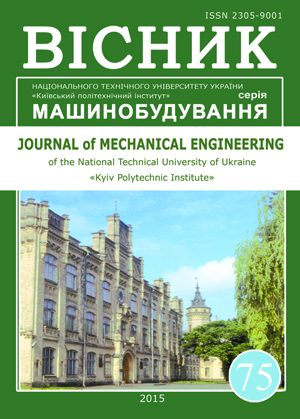MODELING OF LARGE STRAINS. MESSAGE 6. THERMOELASTO-PLASTIC ANALYSIS, TOTAL LAGRANGIAN FORMULATION
DOI:
https://doi.org/10.20535/2305-9001.2015.75.50792Keywords:
large strains, Total Lagrangian, multiplicative decomposition, thermoelasto-plastic analysis, algorithm, FEMAbstract
. It was considered in previous articles (Reports 1,2,3 and 4) how the idea of Lee's multiplicative decomposition of the elastic-plastic Cauchy-Green deformation gradient can be implemented to a generalized decomposition of thermal, elastic, plastic and creep deformations gradient and the admissible forms of the constitutive state equations were established. The objective of the 5-th report is to determine which type of the reference configuration 'unloaded' or 'initial' is more suitable in case of thermo-elasticity with respect to general hyper-elastic postulates. The purpose of this Message – to offer version of effective algorithm for the solution of thermoelasto-plasticity problems with the large strains. Applied proved on the basis of the second law of thermodynamics the law of plastic flow, multiplicative decomposition of a gradient thermoelasto-plastic deformations Koshi-Green, Total Lagrangian formulation and the approach when elastic and plastic deformations are determined concerning the "unloaded" condition. A material – isotropic metal. Have developed effective is finite-element algorithm of calculation of stresses and the large strains in a firm body from an isotropic material at thermoelasto-plasticity, in Total Lagrangian formulation. The algorithm is programmed in the author's FEM-program. The algorithm are checked up on a numerical test example. The developed effective algorithm is generalisation of the algorithm offered by author in 1989 for small strains.
References
Rudakov K.M., Dobronravov O.A. [Modelling of large strains. Message 1. Multiplicate decomposition in the presence of four types of strains] J. of Mechanical Engineering of NTUU "KPI", 2012. no.64. pp.7–12.
Rudakov K.M., Jakovlev A.І. [Modelling of large strains. Message 2. The temperature strains] J. of Mechanical Engineering of NTUU "KPI", 2012. no.65, pp.10–18.
Rudakov K.M., Dobronravov O.A. [Modelling of large strains. Message 3. Theoretical bases of use of a logarithmic measure of strains of Hencky] Research Bulletin of NTUU "KPI", 2013. no.6, pp.86–93.
Rudakov K.M., Jakovlev A.І. [Modelling of large strains. Message 4. The physical equations of thermoplasticity and creep at use of a logarithmic measure of strains of Hencky] Research Bulletin of NTUU "KPI", 2013. no.2, pp.110–118.
Rudakov K.M., Iakovliev A.І. [Modelling of large strains. Message 5. Thermoelasticity]. J. of Mechanical Engineering of NTUU "KPI", 2015. no.1(73). pp.43–51.
Lee E.H. Elastic–plastic deformations at finite strains. J. Appl. Mech. (ASME), 1969. 36. pp.1–6.
Eterović A.L., Bathe K.J. A hyperelastic-based large strain elasto–plastic constitutive formulation with combined isotropic-kinematic hardening using the logarithmic stress and strain measures. Int. J. Numer. Meth. Engng, 1990. 30. pp.1099 –1114.
Bathe Klaus-Jürgen. Finite Element Procedures. New Jersey: Prentice-Hall. 1996. 1037 p.
Montans F.J., Bathe K-J. Computational issues in large strain elasto-plasticity: an algorithm for mixed hardening and plastic spin. Int. J. Numer. Meth. Engng, 2005. 63. pp.159 –196.
Korobejnikov S.N. [Nonlinear deformation of firm bodies]. Novosibirsk: Izdatel'stvo SO RAN, 2000. 262 p.
Germain P. [Course of mechanics of continuous environments. General theory] Moskow: Vyssh. shk., 1983. 399 p.
Sedov L.I. [Mechanic of continua] T.1. Moscow: Nauka, 1970. 492 p.
Sedov L.I. [Mechanic of continua] T.1. Moscow: Nauka, 1994. 528 p.
Mandel J. Thermodynamics and plasticity. In Foundations of Continuum Thermodynamics, Delgado J.J., Nina N.R., Whitelaw J.H. (eds). Macmillan: London, 1974. pp.283–304.
Hill R. The Mathematical Theory of Plasticity. Oxford: Clarendon Press, 1950. 355 p.
Rudakov K.N. [Effectiveness of algorithms for determining stresses and plastic deformations in numerical modeling of processes of thermomechanical loading of structural members. J. Strength of Materials, 1992. 24(9). pp.543-548]. Probl. prochnosti. 1992. no.9. pp.18-24.
Rudakov K.N. [Numerical methods of the analysis in dynamics and strength of designs: Manual] K.: NTUU "KPI", 2007. 379 p.
Krieg R.D., Krieg D.B. Accuracies of numerical solution for the elastic-perfectly plastic model. J. Pressure Vessel Technology: Trans. ASME, 1977. 99. no.4. pp.510-515.
Oden Dzh. Konechnye jelementy v nelinejnoj mehanike sploshnyh sred [Oden J.T. Finite elements of nonlinear continua. New York: McGraw-Hill, 1972]. Per. s angl. A.M. Vasil'eva; Pod red. Je.I. Grigoljuka. Moscow: Mir, 1976. 464 p.

